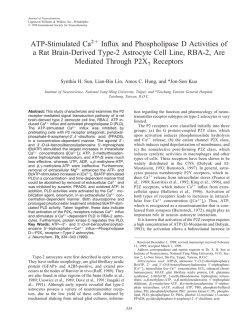
Activating Mutations of the Transmembrane Domain of MPL
From www.bloodjournal.org by guest on February 6, 2015. For personal use only. 2596 17. Fabry ME, Sengupta A, Suzuka SM, Costantini F, Rubin EM, Hofrichter J, Christoph G, Mancie E, Culberson D, Factor SM, Nagel RL: A second generation of transgenic mouse model expressing HbS and HbS-Antilles results in increased phenotypic severity. Blood 86:2419, 1995 CORRESPONDENCE 18. Ikegawa R, Matsumura Y, Tsukahara Y, Takaoka M, Morimoto S: Phosphoramidon, a metalloproteinase inhibitor, suppresses the secretion of endothelin-1 from cultured endothelial cells by inhibiting a big endothelin-1 converting enzyme. Biochem Biophys Res Commun 171:669, 1990 Activating Mutations of the Transmembrane Domain of MPL In Vitro and In Vivo: Incorrect Sequence of MPL-K, an Alternative Spliced Form of MPL To the Editor: Recently, many gene alterations have been identified as causes of leukemia, most of which are gross rearrangements of transcription factors, receptors, and kinases derived from chromosomal translocations. In addition, mutations of tyrosine kinase receptors such as c-kit1 and FLT-32 have been reported in mastocytosis and myeloid leukemia, respectively. In particular, it is noticeable that duplication of the juxtamembrane region of FLT-3 is observed in 20% of patient leukemic cells. However, no cytokine receptors (type I cytokine receptor family) have been reported to be involved in human leukemia except that truncation of the C-terminal domain of the granulocyte colony-stimulating factor (G-CSF) receptor caused by various point mutations is implicated in a fraction of leukemic patients. Most of these leukemias are secondary acute myeloid leukemias (AMLs) developed from Kostmann syndrome, and the significance of the mutations in leukemogenesis is still controversial.3,4 MPL, thrombopoietin (TPO) receptor, is the only hemopoietin receptor (type I cytokine receptor family) identified as an oncogene.5,6 Thus, MPL was originally identified as a truncated form v-mpl that is an oncogene of a murine retrovirus MPLV, which causes myeloproliferative disorders in mice, and was later recognized as a receptor for TPO. Using a combined strategy including polymerase chain reaction (PCR)driven random mutagenesis and retrovirus-mediated high-efficiency gene transfer, we have recently identified a constitutive active form of MPL.7 This point mutation causes a single amino acid substitution from Ser498 to Asn498 in its transmembrane domain. Expression of the mutant MPL in a mouse interleukin-3 (IL-3)–dependent pro-B cell line Ba/F3 resulted in constitutive activation of both the Ras-Raf-MAPK and the Jak-STAT pathways and IL-3–independent growth. Moreover, when the Ba/F3 transfectants expressing the mutant MPL were injected into syngeneic mice after sublethal irradiation, they developed severe infiltration of the Ba/F3 transfectants in liver and spleen, suggesting that the mutant form of MPL is highly oncogenic in vivo. We were interested in whether similar mutations can be found in patients’ leukemic cells, and examined the sequence of the transmembrane portion of MPL in 43 patients, including 2 patients with essential thrombocytosis (ET), 6 with AML-M1, 6 with AML-M2, 1 with AML-M3, 3 with AML-M4, 2 with AML-M5, 9 with AML-M6, 12 with AML-M7 (megakaryoblastic leukemia), and 2 with myelodysplastic syndromes (MDS). To sequence the corresponding part in the patients’ sample and to avoid the contamination of the plasmid harboring the mutant MPL, a DNA fragment spanning the transmembrane portion of MPL (exon 9) and a part of intron 10 of the human MPL gene8 was amplified from high-molecular-weight DNA by PCR using a 5Ј transmembrane primer (ATCTCCTTGGTGACC) and a primer in the 10th intron (AGATCTGGGGTCACACAGAG) (Fig 1). To avoid mutations during the recovery procedure as much as possible, we used Pfu polymerase for the reaction. PCR fragments were subcloned into the TA vector, and at least six subclones were sequenced for each patient. However, no mutations were found in the transmembrane portion of MPL. Our results indicate that the mutation in the transmembrane region of MPL is not a frequent cause of leukemogenesis. There are two major transcripts for MPL, a full-length MPL-P and an alternative splicing form MPL-K.6 MPL-K is supposed to be translated from an alternative spliced mRNA harboring intron 10 after exon 9 encoding the transmembrane region (Fig 1). The function of MPL-K product was not known.6 During the course of our screening for MPL mutations in leukemic patients, we happened to find a sequence error in the sequence of intron 10 that had been published as a part of the MPL-K transcript (Fig 1). Thus, the sequence CG (1616-1617) was GGCC (1616-1619) in all patients tested as well as in a normal control, which will result in frame-shift and earlier termination in the MPL-K product (Fig 2). The predicted length of the intracellular domain of MPL-K should be 36 instead of 66 amino acids. To confirm this, it is required to molecularly clone cDNA for MPL-K and confirm the sequence of the corresponding part. Toshio Kitamura Department of Hemopoietic Factors Institute of Medical Science University of Tokyo Tokyo, Japan Mayumi Onishi Third Department of Internal Medicine University of Tokyo Tokyo, Japan Takashi Yahata Department of Immunology Tokai University School of Medicine Isehara, Japan Yuzuru Kanakura Department of Hematology and Oncology Osaka University Suita, Japan Shigetaka Asano Department of Internal Medicine Institute of Medical Science University of Tokyo Tokyo, Japan Fig 1. PCR primers to amplify the transmembrane region of MPL from genomic DNA. TM (shadowed box), transmembrane region; arrows, PCR primers. From www.bloodjournal.org by guest on February 6, 2015. For personal use only. CORRESPONDENCE 2597 Fig 2. Structures of MPL-P and MPL-K. Amino acid sequences of the C-terminal half of the transmembrane region and the intracellular region are shown for MPL-P and MPL-K together with the putative correct MPL-K (MPL-Kc). The underlined sequence indicates the C-terminal half of the transmembrane domain. The amino acid sequences that are common between MPL-P and MPL-K and between MPL-K and MPL-Kc are indicated by vertical lines. The numbers on both sides are the amino acid number from the first methionine. REFERENCES 1. Nagata H, Worobec AS, OH CK, Chowdhury BA, Tannenbaum S, Suzuki Y, Metcalfe DD: Identification of a point mutation in the catalytic domain of the protooncogene c-kit in peripheral blood mononuclear cells of patients who have mastocytosis with an associated hematologic disorder. Proc Natl Acad Sci USA 92:10560, 1995 2. Yokota S, Kiyoi H, Nakao M, Iwai T, Misawa S, Okuda T, Sonoda Y, Abe T, Kashima K, Matsuo Y, Naoe T: Internal tandem duplication of the FLT3 gene is preferentially seen in acute myeloid leukemia and myelodysplastic syndrome among various hematological malignancies. A study on a large series of patients and cell lines. Leukemia 11:1605, 1997 3. Touw IP, Dong F: Severe congenital neutropenia terminating in acute myeloid leukemia: Disease progression associated with mutations in the granulocyte-colony stimulating factor receptor gene. Leuk Res 20:629, 1996 4. de Koning JP, Touw IP: Advances in understanding the biology and function of the G-CSF receptor. Curr Opin Hematol 3:180, 1996 5. Souyri M, Vigon I, Penciolelli JF, Heard JM, Tambourin P, Wending F: A putative truncated cytokine receptor gene transduced by the myeloproliferative leukemia virus immortalizes hematopoietic progenitors. Cell 63:1137, 1990 6. Vigon I, Mornon JP, Cocault L, Mitjavila MT, Tambourin P, Gisselbrecht S, Souyri M: Molecular cloning and characterization of MPL, the human homolog of the v-mpl oncogene: Identification of the hemopoietic growth factor receptor superfamily. Proc Natl Acad Sci USA 89:5640, 1992 7. Onishi M, Mui ALF, Morikawa Y, Cho L, Kinoshita S, Nolan GP, Miyajima A, Kitamura T: Identification of an oncogenic form of the thrombopoietin receptor MPL using retrovirus-mediated gene transfer. Blood 88:1399, 1996 8. Mignotte V, Vigon I, de Crevecoeur EB, Romeo PH, Lemarchandel V, Chretien S: Structure and transcription of the human c-mpl gene (MPL). Genomics 20:5, 1994 Prediction of Human Herpesvirus 6 Infection After Allogeneic Bone Marrow Transplantation To the Editor: Human herpesvirus 6 (HHV-6) is a recently discovered member of the human herpesvirus family.1 Although primary infection with variant B HHV-6 causes exanthem subitum,2 the clinical features of variant A HHV-6 infection remains unclear. The virus probably latently infects the body after the primary infection and then reactivates in an immunosuppressed state like other human herpesviruses. HHV-6 has recently been recognized as an opportunistic pathogen in transplant recipients.3-7 It has been shown that HHV-6 might be associated with fever and skin rash resembling acute graft-versus-host disease (GVHD),3 interstitial pneumonitis,4 encephalitis,6 and bone marrow suppression7 after bone marrow transplantation (BMT). Since infection with the virus after BMT could be fatal,6 it is important to prevent the infection. Therefore, if we are able to predict HHV-6 infection after BMT, it should prove invaluable in helping to prevent the virus infection. There are two likely sources for HHV-6 infection after BMT: one is reactivation from the recipient body and another is infection via the donor marrow from a seropositive donor. Therefore, virus genome latently infected in peripheral blood mononuclear cells (PBMCs) of donors and recipients could be an important source of the virus infection after transplantation. The aim of this study is to determine whether the presence of HHV-6 genome in PBMCs before BMT is a valuable predictor of virus infection after BMT. We also analyzed whether HHV-6 antibody titers of donors and recipients at the time of transplantation were associated with virus infection. Thirty recipients (20 male and 10 female), who received allogeneic BMT at the Children’s Medical Center of the Japanese Red Cross Nagoya First Hospital, and their donors, were employed in this study. All guardians of these patients consented to be in this study. Patient characteristics relating to age, sex, and underlying disease are summarized in Table 1. The median age of these recipients was 5.9 years old (ranging from 1 year to 15 years old) at the time of transplantation. EDTA peripheral blood samples were collected from donor and recipient pairs at the time of transplantation. In addition, EDTA blood samples were collected at 2 weeks before transplantation and biweekly after transplantation until 2 months after transplantation from recipients. We attempted to isolate HHV-6 from PBMCs and measure antibody titers to HHV-6 by indirect immunofluorescence assay. We also analyze for the presence of HHV-6 DNA in PBMCs obtained from the donor at the time of BMT and from the recipient at 2 weeks before BMT. Five hundred nanograms of DNA extracted from PBMCs obtained from recipients approximately 2 weeks before transplantation and from donors at the time of transplantation was used for nested polymerase chain reaction (PCR) amplification. Nested PCR was performed for amplification of HHV-6 DNA by using two primer sets (A/C, HS6AE/ HS6AF) as previously described.8 The PCR resulted in the amplification of a 751-bp DNA fragment encoding a putative large tegument protein gene. The type of HHV-6 was determined by the presence of an HindIII site in each second PCR product. The sensitivity of the PCR assay was determined with the use of serial dilutions of the plasmid, pSTY-05 (kindly provided by Dr K. Yamanishi, Department of Bacteriology, Osaka University, Osaka, Japan). As shown in Fig 1, we could routinely detect 100 copies of the virus genome. To ensure the accuracy of each PCR assay, dilutions containing 100 copies and 10 copies of the plasmid were coamplified with each of the samples in the following analyses. Statistical analyses were performed by using Fisher’s exact test and Student’s t-test. If HHV-6 was isolated from PBMCs or a significant increase of From www.bloodjournal.org by guest on February 6, 2015. For personal use only. 1998 92: 2596-2597 Activating Mutations of the Transmembrane Domain of MPL In Vitro and In Vivo: Incorrect Sequence of MPL-K, an Alternative Spliced Form of MPL Toshio Kitamura, Mayumi Onishi, Takashi Yahata, Yuzuru Kanakura and Shigetaka Asano Updated information and services can be found at: http://www.bloodjournal.org/content/92/7/2596.full.html Articles on similar topics can be found in the following Blood collections Information about reproducing this article in parts or in its entirety may be found online at: http://www.bloodjournal.org/site/misc/rights.xhtml#repub_requests Information about ordering reprints may be found online at: http://www.bloodjournal.org/site/misc/rights.xhtml#reprints Information about subscriptions and ASH membership may be found online at: http://www.bloodjournal.org/site/subscriptions/index.xhtml Blood (print ISSN 0006-4971, online ISSN 1528-0020), is published weekly by the American Society of Hematology, 2021 L St, NW, Suite 900, Washington DC 20036. Copyright 2011 by The American Society of Hematology; all rights reserved.
© Copyright 2025

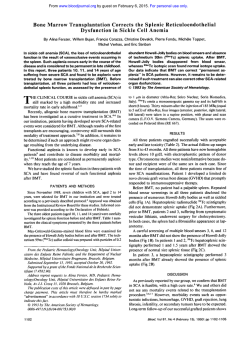



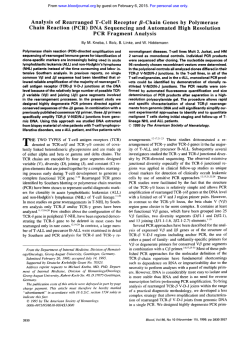
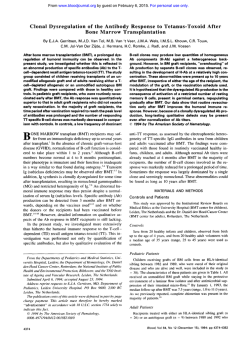
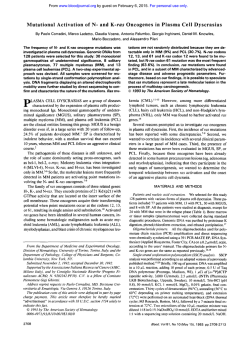
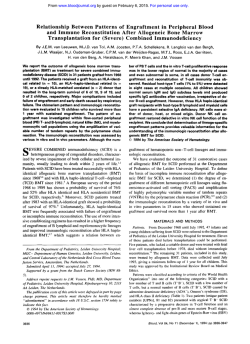
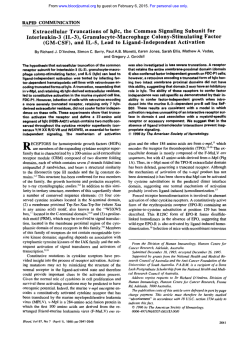
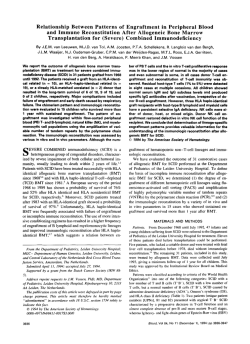
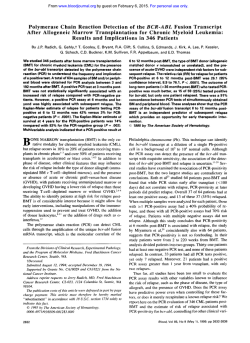
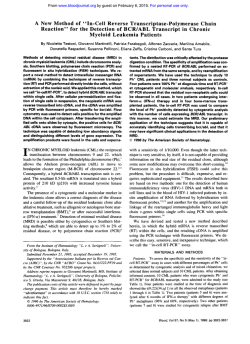
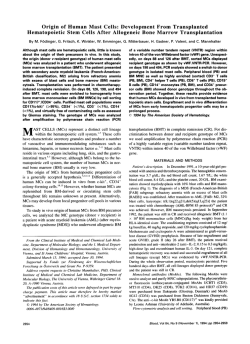
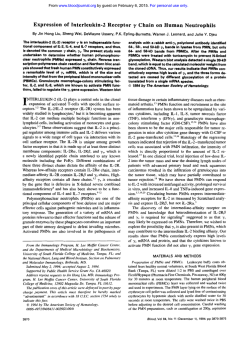
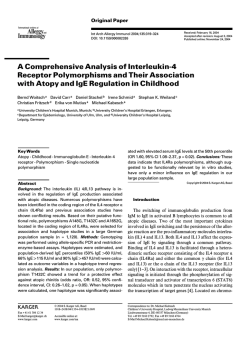
![Download [ PDF ] - journal of evolution of medical and dental sciences](http://s2.esdocs.com/store/data/000488959_1-4dca276881c4179da54bcce462126ef6-250x500.png)
